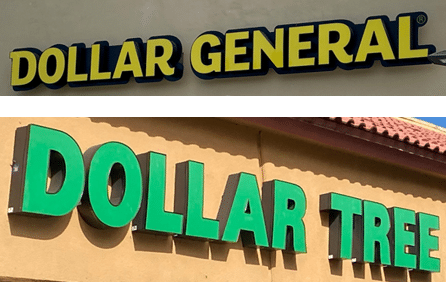We know competitive advantages come in many forms. We will share Wall Street Journal summaries** on both stores and our cautions.
Dollar General is best known for locating in the hinterlands of rural America. Middle of nowhere is where they have been successful. They usually lease rather than own stores and pay low wages. That works well when there are only a handful of jobs available in a region, or are miles from a town or a Walmart. They serve populations of 20,000 or less and households earning $40,000 a year or less. They sell a limited number of products with many being more than one dollar despite the name. They serve their customers more like an inexpensive convenience store.
How successful is this model? Well, they boast $30B in sales with a solid 30-year sales growth. They keep employee count to a minimum and have 157,000 employees and are approaching 18,000 stores across 46 states. Even in the pandemic they were able to tout 16% growth. They have 5.2% of all the brick and mortar stores in the U.S.
They buy in bulk and do not usually mess with produce, avoiding waste dollars. Their growth model mimics the growth model of early Walmart.
Dollar General now plans to move to more urban areas, stock produce, party supplies, etc. This is a company that has maintained a very successful business model and solid competitive advantages. One might guess they have not run out of rural areas in need of a present-model Dollar General. History tells us you can’t be all things to all people or rather in this case, be “the model you are to all markets.”
Bigger isn’t always better. We have repeatedly seen small and mid-sized CEOs make that mistake only to return to smaller volume with higher profits.
On the other hand, Dollar Tree is rethinking their business model. They are facing rising inflation, rising shipping expenses, and wage pressure for its part-time employees. Consequently, they plan to experiment with some higher priced items. Unlike Dollar General, their 15,000+ stores are in more high rent urban areas and target more middle-income shoppers.
Dollar Tree also competes more directly with Walmart, Aldi, and other outlets targeted to the same demographic, not to mention online providers. In fact, their early strategy was to build within two miles of a Walmart. How they adjust their business model going forward will dictate their ability to thrive. There are fewer competitive advantages left for Dollar Tree today.
Dollar General may be wise to review the current challenges facing Dollar Tree before diving into urban/suburban markets during an inflationary period. Today’s economy is very different from when Walmart chose to expand into urban/suburban areas. 30-40 years ago, many of those areas didn’t have many retail options for lower-to-middle income shoppers. So, following the Walmart strategy of building a rural base and then expanding into more developed areas has a whole different set of challenges today.
As you review your company’s economic landscape, do you have more in common with Dollar General or Dollar Tree? What decisions might you be making today about your existing competitive advantages that might either put them at risk, or give you an even better edge? Are you focused on that which the market truly needs and wants? Or are your decisions internally based on your “wish list of goals”?
Peter Drucker said “90% of information used in organizations is internally focused and 10% is about the outside environment. That is exactly backwards.” It is always best to do your research before making big strategic decisions.
** “Dollar Tree to Sell More Items Above $1 as Costs Rise” (September 30, 2021)“
It Doesn’t Pay to Bet Against Dollar General” (August 27, 2021)

